MLS-Net: An Automatic Sleep Stage Classifier Utilizing Multimodal Physiological Signals in Mice
Abstract
1. Introduction
- (1)
- We propose a novel rodent automatic sleep classifier, MLS-Net, that demonstrates superior performance compared with other classifiers, achieving an overall accuracy rate of 90.4%.
- (2)
- Our proposed model is based on a multimodal paradigm that takes multimodal signals (EEG, EMG, and EMs) as input. The employment of EM signals enhances the detection of REM sleep, achieving a precision of 91.1%, sensitivity of 84.7%, and an F1-Score of 87.5% in mice.
- (3)
- We will open-source this multimodal dataset to foster broader research in sleep studies.
- (4)
- Our system achieves an inference time of 86.1 s for 24 h sleep recordings, which show strong potential for real-time applications.
2. Related Works
2.1. Different Approaches for ASSC in Human Dataset
2.2. Different Approaches for ASSC in Mice
| Type | Classifier | Dataset | Channels | Validation | Accuracy | Ref. |
|---|---|---|---|---|---|---|
| Machine learning algorithm | Auto-Scorer | 6 rats | EEG, EMG | Intra-lab | 80.24% | 2009 [55] |
| LDA | 10 mice | EEG | Intra-lab | 89% | 2010 [15] | |
| PCA/NBC | 12 mice | EEG, EMG | Intra-lab | 90% | 2015 [56] | |
| RF | Rhesus macaques, | EEG, EMG and ACT | Across-species | Macaques: 66% | 2020 [13] | |
| Mice, | Mice: 81% | |||||
| Rat, | Rat: 77% | |||||
| Dog | Dogs: 64% | |||||
| SleepEns | 28 mice | EEG, EMG | Intra-lab | 90% | 2023 [54] | |
| Neural network | HMM+CNN | 14 mice and 8 rats | EEG, EMG | Cross-Lab | 93–99% | 2019 [17] |
| (SPINDLE dataset) | ||||||
| CNN+LSTM | Large-scale dataset (4200 recordings); | EEG, EMG | Intra-lab | 96.60% | 2019 [58] | |
| Small dataset (14 recordings) | ||||||
| CNN | Rhesus macaques, | EEG, EMG and ACT | Across-species | Macaques: 75% | 2020 [13] | |
| Mice, | Mice: 83% | |||||
| Rat, | Rat: 78% | |||||
| Dog | Dogs: 73% | |||||
| CNN | 7 mice | EEG, EMG | Intra-lab | 85–90% | 2020 [57] | |
| CNN-LSTM | 216 recordings (UNST-L dataset) | EEG | Intra-lab | 90% | 2021 [30] | |
| CNN | 20 mice from intra-lab; | Image dataset from EEG, EMG | Intra and cross-lab | Intra-lab: 86% | 2021 [60] | |
| AccuSleep dataset | Cross-lab: >85% | |||||
| Residual | 5 mice | EEG, EMG | Intra-lab | 97% | 2024 [59] | |
| Networks | ||||||
| Pre-defined features and LSTM-MLP | 7 mice from intra-lab; | EEG, EMG, EMs | Intra-lab | Intra-lab: 90.4% | Our work | |
| AccuSleep dataset | cross-lab | Cross-lab: 89.9% |
2.3. Comparisons of MLS-Net with Prior Studies
3. Materials and Methods
3.1. Animal
3.2. Multimodal Dataset Design and Implementation
3.3. MLS-Net Model
3.4. Expert-Knowledge-Based Feature Extraction
- (1)
- Amplitude and Power Calculation for EEG Signals:where F(w, t) is the FFT of the signal at time t and frequency ω, and T is the total duration. This formula is general for EEG, EMG, and EMs by changing the subscript “signal” to the respective signal type.
- (2)
- Spectral Power Features for EEG:where band specifies the frequency band (e.g., PEEG(δ) ϵ [0.45 Hz, 4 Hz], E(θ) ϵ [6 Hz–9 Hz], upper E(θ) [7 Hz, 8.5 Hz], E(α) ϵ [8 Hz, 12 Hz], PEEG(ω) ϵ [0 Hz, 30 Hz], upper E(γ) ϵ [52 Hz, 70 Hz]). The upper E(θ) and upper E(γ) have been proven to be effective for discriminating between sleep and wake [15]. flow and fhigh are the boundaries of the frequency band, and start and end define the time window.
- (3)
- Theta/Delta Ratio and Sleep State EM Features:where PEEG (theta)and PEEG (delta) are power computations in the theta (6–9 Hz) and delta (0.45–4 Hz) bands, respectively, and Astate denotes the threshold values (mean ± 1.96 × std.) of EMs during different periods (wakefulness or REM). FEMs(state) represent the frequency of EMs exceeding Awake and AREM thresholds in the current epoch.
- (4)
- The root mean squared (RMS) of EMG:
3.5. Evaluation
3.6. The Construction of Rebalance Dataset Using Data Augmentation
4. Result
4.1. Dataset
4.2. The Performance of MLS-Net and Its Variants
4.3. Performance Comparison of Various Classifiers
4.4. The Performance of Different Classifiers on Balanced Dataset
4.5. The Influence of EM Signals on MLS-Net Model
4.6. External Validation of MLS-Net Model
5. Discussion
5.1. Hybrid of Feature-Based and Neural Network Methodology
5.2. EM Signals during REM Sleep Contributes to Sleep Classification
5.3. Limitations and Future Perspectives
6. Conclusions
Author Contributions
Funding
Institutional Review Board Statement
Informed Consent Statement
Data Availability Statement
Conflicts of Interest
References
- Girardeau, G.; Lopes-Dos-Santos, V. Brain neural patterns and the memory function of sleep. Science 2021, 374, 560–564. [Google Scholar] [CrossRef]
- Zoubek, L.; Charbonnier, S.; Lesecq, S.; Buguet, A.; Chapotot, F. Feature selection for sleep/wake stages classification using data driven methods. Biomed. Signal Process. Control 2007, 2, 171–179. [Google Scholar] [CrossRef]
- Redmond, S.J.; Heneghan, C. Cardiorespiratory-based sleep staging in subjects with obstructive sleep apnea. IEEE Trans. Biomed. Eng. 2006, 53, 485–496. [Google Scholar] [CrossRef]
- Riemann, D.; Nissen, C.; Palagini, L.; Otte, A.; Perlis, M.L.; Spiegelhalder, K. The neurobiology, investigation, and treatment of chronic insomnia. Lancet Neurol. 2015, 14, 547–558. [Google Scholar] [CrossRef]
- Toth, L.A.; Bhargava, P. Animal models of sleep disorders. Comp. Med. 2013, 63, 91–104. [Google Scholar]
- Bixler, E.O.; Kales, A.; Vela-Bueno, A.; Drozdiak, R.A.; Jacoby, J.A.; Manfredi, R.L. Narcolepsy/cataplexy. III: Nocturnal sleep and wakefulness patterns. Int. J. Neurosci. 1986, 29, 305–316. [Google Scholar] [CrossRef]
- Vassalli, A.; Dellepiane, J.M.; Emmenegger, Y.; Jimenez, S.; Vandi, S.; Plazzi, G.; Franken, P.; Tafti, M. Electroencephalogram paroxysmal theta characterizes cataplexy in mice and children. Brain 2013, 136, 1592–1608. [Google Scholar] [CrossRef]
- Paterson, L.M.; Nutt, D.J.; Wilson, S.J. Sleep and its disorders in translational medicine. J. Psychopharmacol. 2011, 25, 1226–1234. [Google Scholar] [CrossRef]
- Lacroix, M.M.; de Lavilléon, G.; Lefort, J.; El Kanbi, K.; Bagur, S.; Laventure, S.; Dauvilliers, Y.; Peyron, C.; Benchenane, K. Improved sleep scoring in mice reveals human-like stages. bioRxiv 2018. [CrossRef]
- Penzel, T.; Conradt, R. Computer based sleep recording and analysis. Sleep Med. Rev. 2000, 4, 131–148. [Google Scholar] [CrossRef]
- Crisler, S.; Morrissey, M.J.; Anch, A.M.; Barnett, D.W. Sleep-stage scoring in the rat using a support vector machine. J. Neurosci. Methods 2008, 168, 524–534. [Google Scholar] [CrossRef]
- Gao, V.; Turek, F.; Vitaterna, M. Multiple classifier systems for automatic sleep scoring in mice. J. Neurosci. Methods 2016, 264, 33–39. [Google Scholar] [CrossRef]
- Svetnik, V.; Wang, T.C.; Xu, Y.; Hansen, B.J.; Fox, S.V. A Deep Learning Approach for Automated Sleep-Wake Scoring in Pre-Clinical Animal Models. J. Neurosci. Methods 2020, 337, 108668. [Google Scholar] [CrossRef]
- Chen, T.; Guestrin, C. XGBoost. In Proceedings of the 22nd ACM SIGKDD International Conference on Knowledge Discovery and Data Mining, San Francisco, CA, USA, 13–17 August 2016; pp. 785–794. [Google Scholar]
- Brankack, J.; Kukushka, V.I.; Vyssotski, A.L.; Draguhn, A. EEG gamma frequency and sleep-wake scoring in mice: Comparing two types of supervised classifiers. Brain Res. 2010, 1322, 59–71. [Google Scholar] [CrossRef] [PubMed]
- Shao, X.; Soo Kim, C. A Hybrid Deep Learning Scheme for Multi-Channel Sleep Stage Classification. Comput. Mater. Contin. 2022, 71, 889–905. [Google Scholar] [CrossRef]
- Miladinovic, D.; Muheim, C.; Bauer, S.; Spinnler, A.; Noain, D.; Bandarabadi, M.; Gallusser, B.; Krummenacher, G.; Baumann, C.; Adamantidis, A.; et al. SPINDLE: End-to-end learning from EEG/EMG to extrapolate animal sleep scoring across experimental settings, labs and species. PLoS Comput. Biol. 2019, 15, e1006968. [Google Scholar] [CrossRef] [PubMed]
- Malafeev, A.; Laptev, D.; Bauer, S.; Omlin, X.; Wierzbicka, A.; Wichniak, A.; Jernajczyk, W.; Riener, R.; Buhmann, J.; Achermann, P. Automatic Human Sleep Stage Scoring Using Deep Neural Networks. Front. Neurosci. 2018, 12, 781. [Google Scholar] [CrossRef] [PubMed]
- Bresch, E.; Grossekathofer, U.; Garcia-Molina, G. Recurrent Deep Neural Networks for Real-Time Sleep Stage Classification from Single Channel EEG. Front. Comput. Neurosci. 2018, 12, 85. [Google Scholar] [CrossRef] [PubMed]
- Yue, H.; Chen, Z.; Guo, W.; Sun, L.; Dai, Y.; Wang, Y.; Ma, W.; Fan, X.; Wen, W.; Lei, W. Research and application of deep learning-based sleep staging: Data, modeling, validation, and clinical practice. Sleep Med. Rev. 2024, 74, 101897. [Google Scholar] [CrossRef]
- Fiorillo, L.; Puiatti, A.; Papandrea, M.; Ratti, P.L.; Favaro, P.; Roth, C.; Bargiotas, P.; Bassetti, C.L.; Faraci, F.D. Automated sleep scoring: A review of the latest approaches. Sleep Med. Rev. 2019, 48, 101204. [Google Scholar] [CrossRef]
- Sultana, A.; Islam, R. Machine learning framework with feature selection approaches for thyroid disease classification and associated risk factors identification. J. Electr. Syst. Inf. Technol. 2023, 10, 1–23. [Google Scholar] [CrossRef]
- Bastianini, S.; Berteotti, C.; Gabrielli, A.; Lo Martire, V.; Silvani, A.; Zoccoli, G. Recent developments in automatic scoring of rodent sleep. Arch. Ital. Biol. 2015, 153, 58–66. [Google Scholar]
- Avci, C.; Akbas, A. Sleep apnea classification based on respiration signals by using ensemble methods. Biomed. Mater. Eng. 2015, 26 (Suppl. S1), S1703–S1710. [Google Scholar]
- Sun, J.; Hu, X.; Peng, S.; Peng, C.K.; Ma, Y. Automatic classification of excitation location of snoring sounds. J. Clin. Sleep Med. 2021, 17, 1031–1038. [Google Scholar] [CrossRef]
- Lazazzera, R.; Deviaene, M.; Varon, C.; Buyse, B.; Testelmans, D.; Laguna, P.; Gil, E.; Carrault, G. Detection and Classification of Sleep Apnea and Hypopnea Using PPG and SpO (2) Signals. IEEE Trans. Biomed. Eng. 2021, 68, 1496–1506. [Google Scholar] [CrossRef]
- Toma, T.I.; Choi, S. An End-to-End Multi-Channel Convolutional Bi-LSTM Network for Automatic Sleep Stage Detection. Sensors 2023, 23, 4950. [Google Scholar] [CrossRef]
- Sun, C.; Chen, C.; Fan, J.; Li, W.; Zhang, Y.; Chen, W. A hierarchical sequential neural network with feature fusion for sleep staging based on EOG and RR signals. J. Neural. Eng. 2019, 16, 066020. [Google Scholar] [CrossRef]
- Barger, Z.; Frye, C.G.; Liu, D.; Dan, Y.; Bouchard, K.E. Robust, automated sleep scoring by a compact neural network with distributional shift correction. PLoS ONE 2019, 14, e0224642. [Google Scholar] [CrossRef]
- Tezuka, T.; Kumar, D.; Singh, S.; Koyanagi, I.; Naoi, T.; Sakaguchi, M. Real-time, automatic, open-source sleep stage classification system using single EEG for mice. Sci. Rep. 2021, 11, 11151. [Google Scholar] [CrossRef]
- Aboalayon, K.; Faezipour, M.; Almuhammadi, W.; Moslehpour, S. Sleep Stage Classification Using EEG Signal Analysis: A Comprehensive Survey and New Investigation. Entropy 2016, 18, e18090272. [Google Scholar] [CrossRef]
- Koch, H.; Christensen, J.A.; Frandsen, R.; Zoetmulder, M.; Arvastson, L.; Christensen, S.R.; Jennum, P.; Sorensen, H.B. Automatic sleep classification using a data-driven topic model reveals latent sleep states. J. Neurosci. Methods 2014, 235, 130–137. [Google Scholar] [CrossRef]
- Boostani, R.; Karimzadeh, F.; Nami, M. A comparative review on sleep stage classification methods in patients and healthy individuals. Comput. Methods Programs Biomed. 2017, 140, 77–91. [Google Scholar] [CrossRef]
- Rahman, M.M.; Bhuiyan, M.I.H.; Hassan, A.R. Sleep stage classification using single-channel EOG. Comput. Biol. Med. 2018, 102, 211–220. [Google Scholar] [CrossRef]
- Yoon, Y.S.; Hahm, J.; Kim, K.K.; Park, S.K.; Oh, S.W. Non-contact home-adapted device estimates sleep stages in middle-aged men: A preliminary study. Technol. Health Care 2020, 28, 439–446. [Google Scholar] [CrossRef]
- Phan, H.; Andreotti, F.; Cooray, N.; Chen, O.Y.; De Vos, M. Joint Classification and Prediction CNN Framework for Automatic Sleep Stage Classification. IEEE Trans. Biomed. Eng. 2019, 66, 1285–1296. [Google Scholar] [CrossRef] [PubMed]
- Chambon, S.; Galtier, M.N.; Arnal, P.J.; Wainrib, G.; Gramfort, A. A Deep Learning Architecture for Temporal Sleep Stage Classification Using Multivariate and Multimodal Time Series. IEEE Trans. Neural Syst. Rehabil. Eng. 2018, 26, 758–769. [Google Scholar] [CrossRef] [PubMed]
- Phan, H.; Andreotti, F.; Cooray, N.; Chen, O.Y.; Vos, M. Automatic Sleep Stage Classification Using Single-Channel EEG: Learning Sequential Features with Attention-Based Recurrent Neural Networks. Annu. Int. Conf. IEEE Eng. Med. Biol. Soc. 2018, 2018, 1452–1455. [Google Scholar]
- Fraiwan, L.; Alkhodari, M. Neonatal sleep stage identification using long short-term memory learning system. Med. Biol. Eng. Comput. 2020, 58, 1383–1391. [Google Scholar] [CrossRef] [PubMed]
- Dong, H.; Supratak, A.; Pan, W.; Wu, C.; Matthews, P.M.; Guo, Y. Mixed Neural Network Approach for Temporal Sleep Stage Classification. IEEE Trans. Neural Syst. Rehabil. Eng. 2018, 26, 324–333. [Google Scholar] [CrossRef]
- Stephansen, J.B.; Olesen, A.N.; Olsen, M.; Ambati, A.; Leary, E.B.; Moore, H.E.; Carrillo, O.; Lin, L.; Han, F.; Yan, H.; et al. Neural network analysis of sleep stages enables efficient diagnosis of narcolepsy. Nat. Commun. 2018, 9, 5229. [Google Scholar] [CrossRef]
- Einizade, A.; Nasiri, S.; Sardouie, S.H.; Clifford, G.D. ProductGraphSleepNet: Sleep staging using product spatio-temporal graph learning with attentive temporal aggregation. Neural Netw. 2023, 164, 667–680. [Google Scholar] [CrossRef]
- Awais, M.; Long, X.; Yin, B.; Farooq Abbasi, S.; Akbarzadeh, S.; Lu, C.; Wang, X.; Wang, L.; Zhang, J.; Dudink, J.; et al. A Hybrid DCNN-SVM Model for Classifying Neonatal Sleep and Wake States Based on Facial Expressions in Video. IEEE J. Biomed. Health Inform. 2021, 25, 1441–1449. [Google Scholar] [CrossRef] [PubMed]
- Chen, Z.; Wu, M.; Cui, W.; Liu, C.; Li, X. An Attention Based CNN-LSTM Approach for Sleep-Wake Detection with Heterogeneous Sensors. IEEE J. Biomed. Health Inform. 2021, 25, 3270–3277. [Google Scholar] [CrossRef] [PubMed]
- Lajnef, T.; Chaibi, S.; Ruby, P.; Aguera, P.E.; Eichenlaub, J.B.; Samet, M.; Kachouri, A.; Jerbi, K. Learning machines and sleeping brains: Automatic sleep stage classification using decision-tree multi-class support vector machines. J. Neurosci. Methods 2015, 250, 94–105. [Google Scholar] [CrossRef] [PubMed]
- Motin, M.A.; Karmakar, C.; Palaniswami, M.; Penzel, T.; Kumar, D. Multi-stage sleep classification using photoplethysmographic sensor. R Soc. Open Sci. 2023, 10, 221517. [Google Scholar] [CrossRef]
- Zaman, A.; Kumar, S.; Shatabda, S.; Dehzangi, I.; Sharma, A. SleepBoost: A multi-level tree-based ensemble model for automatic sleep stage classification. Med. Biol. Eng. Comput. 2024, 62, 2769–2783. [Google Scholar] [CrossRef] [PubMed]
- Tripathy, R.K.; Rajendra Acharya, U. Use of features from RR-time series and EEG signals for automated classification of sleep stages in deep neural network framework. Biocybern. Biomed. Eng. 2018, 38, 890–902. [Google Scholar] [CrossRef]
- Phan, H.; Andreotti, F.; Cooray, N.; Chen, O.Y.; De Vos, M. SeqSleepNet: End-to-End Hierarchical Recurrent Neural Network for Sequence-to-Sequence Automatic Sleep Staging. IEEE Trans. Neural Syst. Rehabil. Eng. 2019, 27, 400–410. [Google Scholar] [CrossRef]
- Abbasi, S.F.; Ahmad, J.; Tahir, A.; Awais, M.; Chen, C.; Irfan, M.; Siddiqa, H.A.; Waqas, A.B.; Long, X.; Yin, B.; et al. EEG-Based Neonatal Sleep-Wake Classification Using Multilayer Perceptron Neural Network. IEEE Access 2020, 8, 183025–183034. [Google Scholar] [CrossRef]
- Ansari, A.H.; De Wel, O.; Pillay, K.; Dereymaeker, A.; Jansen, K.; Van Huffel, S.; Naulaers, G.; De Vos, M. A convolutional neural network outperforming state-of-the-art sleep staging algorithms for both preterm and term infants. J. Neural Eng. 2020, 17, 016028. [Google Scholar] [CrossRef] [PubMed]
- Shao, Y.; Huang, B.; Du, L.; Wang, P.; Li, Z.; Liu, Z.; Zhou, L.; Song, Y.; Chen, X.; Fang, Z. Reliable automatic sleep stage classification based on hybrid intelligence. Comput. Biol. Med. 2024, 173, 108314. [Google Scholar] [CrossRef]
- Hunt, J.; Coulson, E.J.; Rajnarayanan, R.; Oster, H.; Videnovic, A.; Rawashdeh, O. Sleep and circadian rhythms in Parkinson’s disease and preclinical models. Mol. Neurodegener. 2022, 17, 2. [Google Scholar] [CrossRef] [PubMed]
- Fraigne, J.J.; Wang, J.; Lee, H.; Luke, R.; Pintwala, S.K.; Peever, J.H. A novel machine learning system for identifying sleep-wake states in mice. Sleep 2023, 46, zsad101. [Google Scholar] [CrossRef] [PubMed]
- Gross, B.A.; Walsh, C.M.; Turakhia, A.A.; Booth, V.; Mashour, G.A.; Poe, G.R. Open-source logic-based automated sleep scoring software using electrophysiological recordings in rats. J. Neurosci. Methods 2009, 184, 10–18. [Google Scholar] [CrossRef] [PubMed]
- Rempe, M.J.; Clegern, W.C.; Wisor, J.P. An automated sleep-state classification algorithm for quantifying sleep timing and sleep-dependent dynamics of electroencephalographic and cerebral metabolic parameters. Nat. Sci. Sleep 2015, 7, 85–99. [Google Scholar] [CrossRef]
- Exarchos, I.; Rogers, A.A.; Aiani, L.M.; Gross, R.E.; Clifford, G.D.; Pedersen, N.P.; Willie, J.T. Supervised and unsupervised machine learning for automated scoring of sleep-wake and cataplexy in a mouse model of narcolepsy. Sleep 2020, 43, zsz272. [Google Scholar] [CrossRef]
- Yamabe, M.; Horie, K.; Shiokawa, H.; Funato, H.; Yanagisawa, M.; Kitagawa, H. MC-SleepNet: Large-scale Sleep Stage Scoring in Mice by Deep Neural Networks. Sci. Rep. 2019, 9, 15793. [Google Scholar] [CrossRef]
- Jha, P.K.; Valekunja, U.K.; Reddy, A.B. SlumberNet: Deep learning classification of sleep stages using residual neural networks. Sci. Rep. 2024, 14, 4797. [Google Scholar] [CrossRef]
- Kam, K.; Rapoport, D.M.; Parekh, A.; Ayappa, I.; Varga, A.W. WaveSleepNet: An interpretable deep convolutional neural network for the continuous classification of mouse sleep and wake. J. Neurosci. Methods 2021, 360, 109224. [Google Scholar] [CrossRef]
- Meng, Q.; Tan, X.; Jiang, C.; Xiong, Y.; Yan, B.; Zhang, J. Tracking Eye Movements During Sleep in Mice. Front. Neurosci. 2021, 15, 616760. [Google Scholar] [CrossRef]
- Senzai, Y.; Scanziani, M. A cognitive process occurring during sleep is revealed by rapid eye movements. Science 2022, 377, 999–1004. [Google Scholar] [CrossRef]
- Judge, S.J.; Richmond, B.J.; Chu, F.C. Implantation of magnetic search coils for measurement of eye position: An improved method. Vis. Res. 1980, 20, 535–538. [Google Scholar] [CrossRef]
- Pei, W.; Li, Y.; Wen, P.; Yang, F.; Ji, X. An automatic method using MFCC features for sleep stage classification. Brain Inform. 2024, 11, 6. [Google Scholar] [CrossRef]
- Fan, J.; Sun, C.; Chen, C.; Jiang, X.; Liu, X.; Zhao, X.; Meng, L.; Dai, C.; Chen, W. EEG data augmentation: Towards class imbalance problem in sleep staging tasks. J. Neural Eng. 2020, 17, 056017. [Google Scholar] [CrossRef]
- Grieger, N.; Schwabedal, J.T.C.; Wendel, S.; Ritze, Y.; Bialonski, S. Automated scoring of pre-REM sleep in mice with deep learning. Sci. Rep. 2021, 11, 12245. [Google Scholar] [CrossRef]
- Tsinalis, O.; Matthews, P.M.; Guo, Y. Automatic Sleep Stage Scoring Using Time-Frequency Analysis and Stacked Sparse Autoencoders. Ann. Biomed. Eng. 2016, 44, 1587–1597. [Google Scholar] [CrossRef]
- Sunagawa, G.A.; Sei, H.; Shimba, S.; Urade, Y.; Ueda, H.R. FASTER: An unsupervised fully automated sleep staging method for mice. Genes Cells 2013, 18, 502–518. [Google Scholar] [CrossRef]
- Aserinsky, E.; Kleitman, N. Regularly occurring periods of eye motility, and concomitant phenomena, during sleep. Science 1953, 118, 273–274. [Google Scholar] [CrossRef]
- Andrillon, T.; Nir, Y.; Cirelli, C.; Tononi, G.; Fried, I. Single-neuron activity and eye movements during human REM sleep and awake vision. Nat. Commun. 2015, 6, 7884. [Google Scholar] [CrossRef]
- Fulda, S.; Romanowski, C.P.; Becker, A.; Wetter, T.C.; Kimura, M.; Fenzel, T. Rapid eye movements during sleep in mice: High trait-like stability qualifies rapid eye movement density for characterization of phenotypic variation in sleep patterns of rodents. BMC Neurosci. 2011, 12, 110. [Google Scholar] [CrossRef]
- Ronzhina, M.; Janousek, O.; Kolarova, J.; Novakova, M.; Honzik, P.; Provaznik, I. Sleep scoring using artificial neural networks. Sleep Med. Rev. 2012, 16, 251–263. [Google Scholar] [CrossRef]
- Yin, J.; Xu, J.; Ren, T.L. Recent Progress in Long-Term Sleep Monitoring Technology. Biosensors 2023, 13, 395. [Google Scholar] [CrossRef]

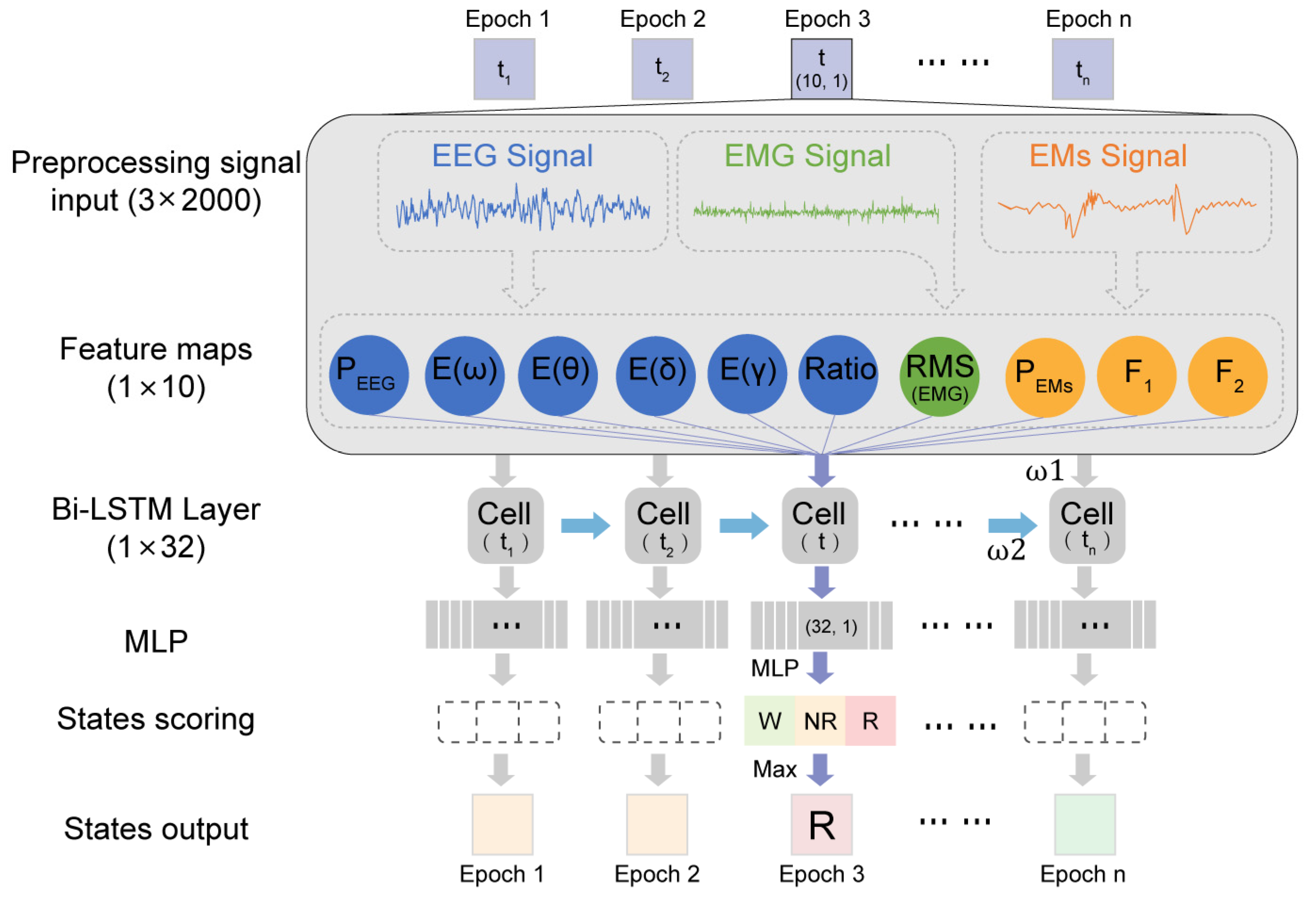

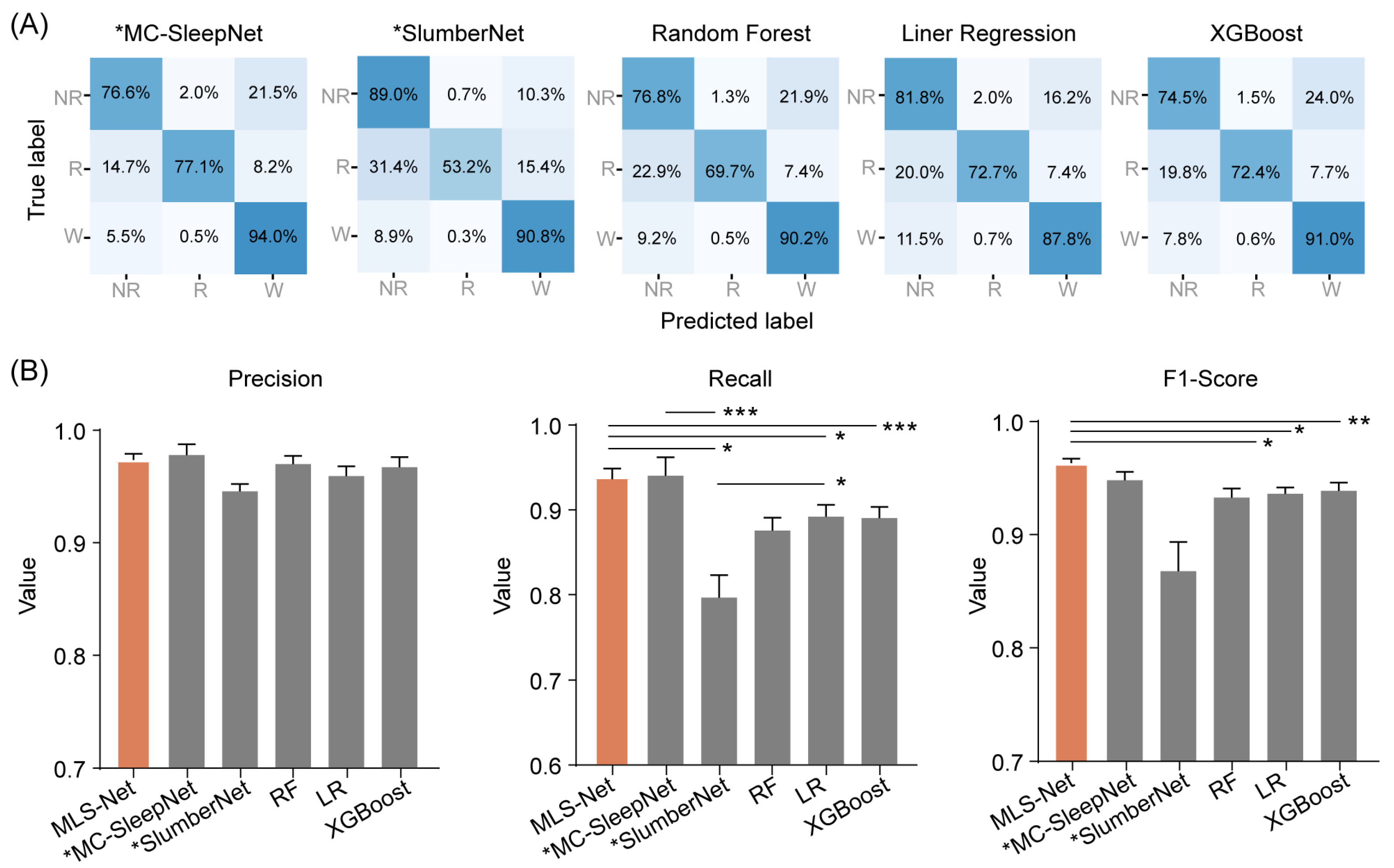
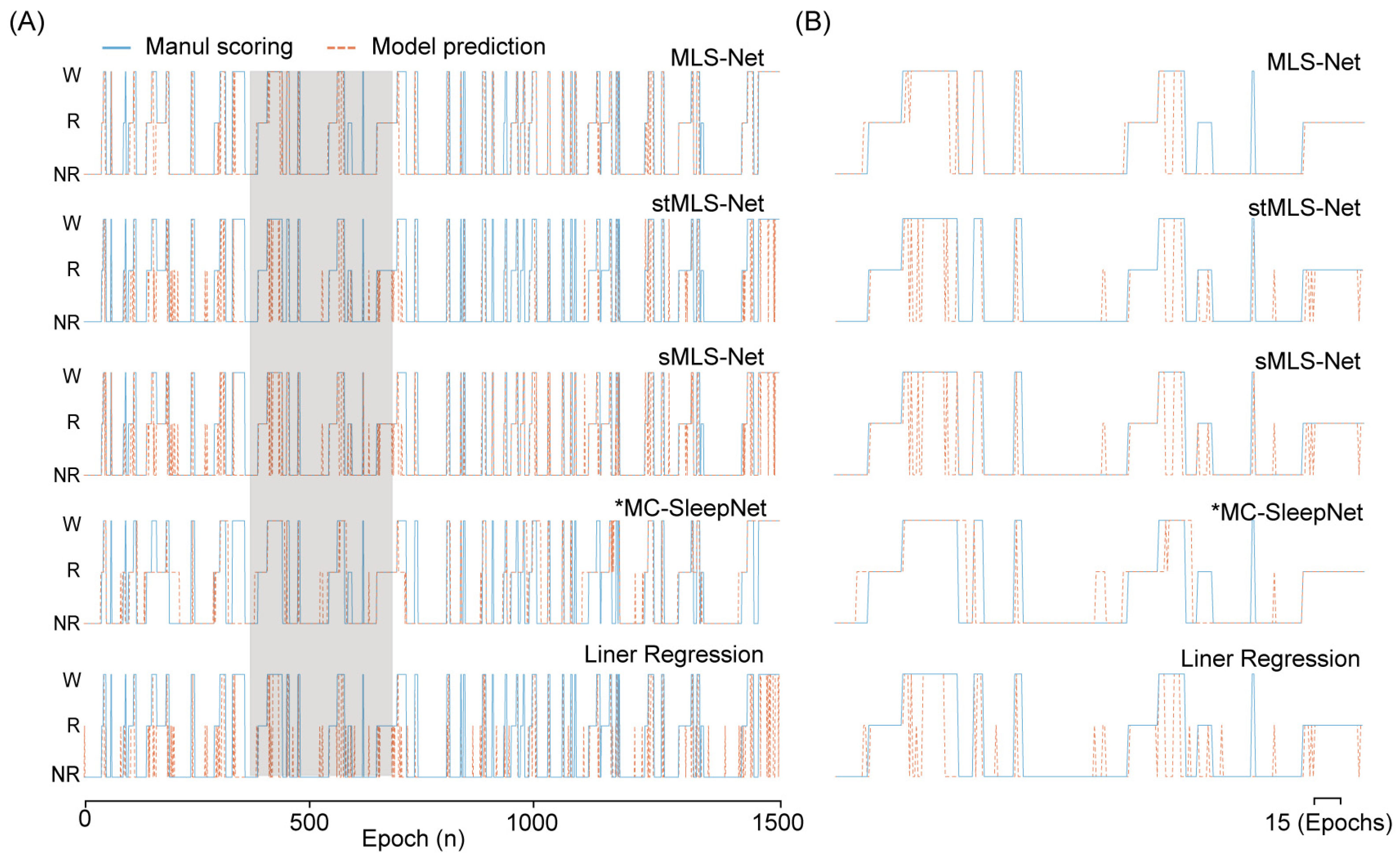

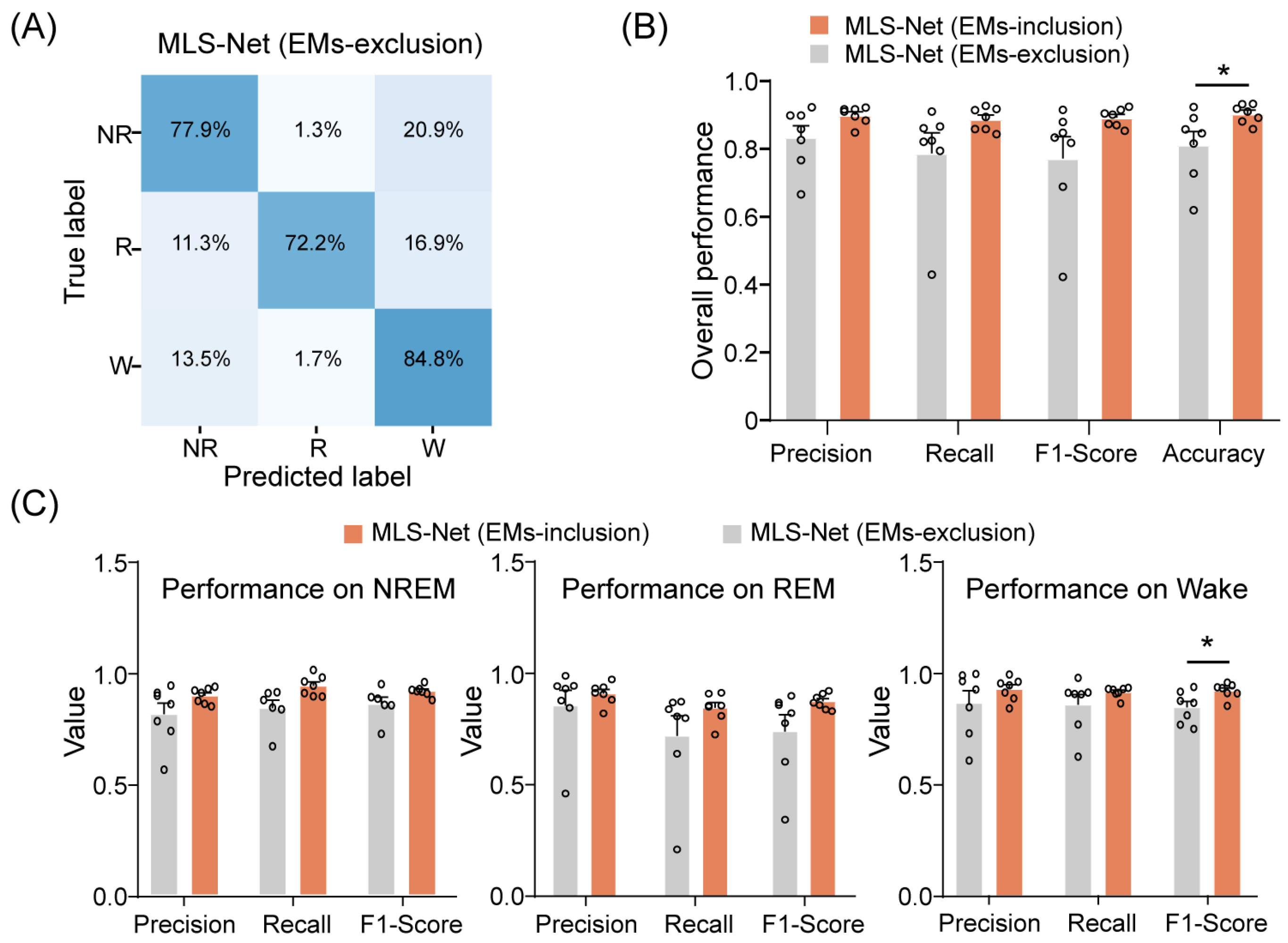
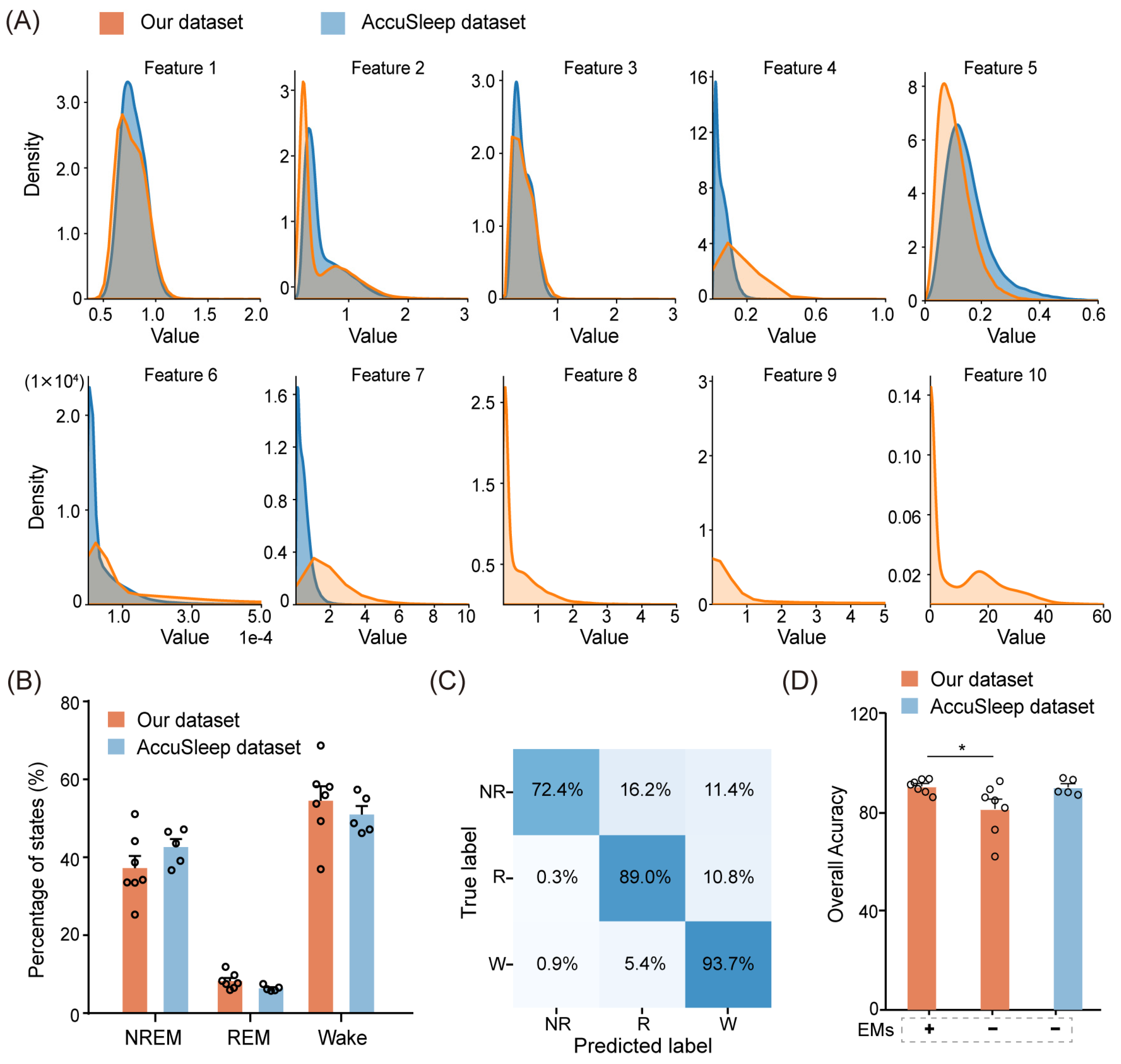
| Type | Classifier | Dataset | Channels | Accuracy | Ref. |
|---|---|---|---|---|---|
| Machine learning algorithm | Dendrogram multi-class SVM | 15 subjects | EOG, EMG, EEG | 88% | 2015 [45] |
| RF | Sleep–EDF dataset and CAP sleep dataset | EEG | 87.49% | 2017 [33] | |
| SVM | Sleep-EDF, Sleep-EDFX and ISRUC-Sleep databases | EOG | SVM: 89.9% | 2018 [34] | |
| RF | RF: 90.2% | ||||
| RUSBoost | RUSBoost:88.6% | ||||
| KNN | 10 subjects | PSG | 98.65% | 2022 [35] | |
| SVM; | 10 subjects | EEG, ECG, PPG, EOG | SVM: 70.05% | 2023 [46] | |
| RF; | RF: 70.75% | ||||
| SleepBoost; CatBoost; GBoost; RF | 20 recordings from Sleep-EDF dataset | EEG, EOG, EMG | 86.30% | 2024 [47] | |
| Neural network | DNN | MIT-BIH database (18 subjects) | EEG, ECG | 73.70% | 2018 [48] |
| RNN + CNN | Montreal Archive of Sleep Studies (200 subjects) | EEG, EOG, EMG. | 87.10% | 2019 [49] | |
| MLP | 30 s segments from 19 | EEG | 82.53% | 2020 [50] | |
| CNN | 42 recordings from University Hospital of Leuven | EEG | 64% | 2020 [51] | |
| CNN + GRUs | SHHS (700 subjects) | EOG, EMG, EEG | 83.15% | 2020 [16] | |
| DCNN + SVM | 19 Chinese neonates at the Children’s Hospital of Fudan University | Vedio, facial expressions | 93.80% | 2021 [43] | |
| CNN + LSTM | Clinical dataset | HRV + acceleration | 94.50% | 2021 [44] | |
| GNN+bi-GRU | MASS; | EOG, EMG, ECG, EEG | 86.70% | 2023 [42] | |
| SleepEDF dataset | 83.80% | ||||
| Traditional machine learning and deep learning techniques. | 100 recordings from ISRUC and 197 recordings from Sleep-EDFx dataset | EEG, EMG, ECG | ISRUC dataset: | 2024 [52] | |
| 80.30% | |||||
| Sleep-EDF dataset: | |||||
| 81% |
| Stage | Total Epochs | Percentage (%) | Training Set (%) | Test Set (%) |
|---|---|---|---|---|
| Wake | 82,449 | 54.5 | 85.7 (6/7) | 14.3 (1/7) |
| REM | 12,465 | 8.2 | ||
| NREM | 56,286 | 37.2 |
| Algorithms | Dataset | EM-Exclusion | Balance | Precision (%) | Recall (%) | F1-Score (%) | Accuracy (%) | Time (s) |
|---|---|---|---|---|---|---|---|---|
| MLS-Net | Our dataset | No | No | 89.9 | 88.8 | 89.2 | 90.4 | 86.1 |
| No | Yes | 74.2 | 79.5 | 81.5 | 81.2 | |||
| Yes | No | 80.8 | 76.8 | 78.4 | 80.6 | |||
| AccuSleep Dataset | -- | No | 90.0 | 85.0 | 87.1 | 89.9 | ||
| stMLS-Net | Our dataset | No | No | 91.6 | 88.9 | 90.0 | 91.4 | 3073.3 |
| Yes | 78.4 | 72.7 | 74.9 | 75.7 | ||||
| sMLS-Net | Our dataset | No | No | 84.3 | 83.6 | 83.9 | 85.8 | 479.8 |
| Yes | 74.1 | 75.4 | 74.7 | 76.4 | ||||
| *MC-SleepNet | Our dataset | No | No | 88.5 | 84.8 | 86.4 | 89.0 | 608.9 |
| Yes | 78.6 | 70.7 | 73.5 | 74.6 | ||||
| *SlumberNet | Our dataset | No | No | 88.0 | 86.5 | 86.0 | 86.5 | 3178.4 |
| Yes | 80.5 | 79.8 | 79.3 | 79.6 | ||||
| RF | Our dataset | No | No | 84.5 | 78.9 | 78.3 | 83.3 | 2.9 |
| Yes | 78.1 | 73.4 | 75.3 | 68.2 | ||||
| LR | Our dataset | No | No | 83.9 | 80.8 | 82.2 | 73.1 | 10.7 |
| Yes | 76.3 | 72.0 | 73.8 | 67.7 | ||||
| XGBoost | Our dataset | No | No | 73.4 | 59.5 | 48.0 | 83.6 | 22.1 |
| Yes | 76.5 | 73.4 | 74.4 | 67.3 |
Disclaimer/Publisher’s Note: The statements, opinions and data contained in all publications are solely those of the individual author(s) and contributor(s) and not of MDPI and/or the editor(s). MDPI and/or the editor(s) disclaim responsibility for any injury to people or property resulting from any ideas, methods, instructions or products referred to in the content. |
© 2024 by the authors. Licensee MDPI, Basel, Switzerland. This article is an open access article distributed under the terms and conditions of the Creative Commons Attribution (CC BY) license (https://creativecommons.org/licenses/by/4.0/).
Share and Cite
Jiang, C.; Xie, W.; Zheng, J.; Yan, B.; Luo, J.; Zhang, J. MLS-Net: An Automatic Sleep Stage Classifier Utilizing Multimodal Physiological Signals in Mice. Biosensors 2024, 14, 406. https://doi.org/10.3390/bios14080406
Jiang C, Xie W, Zheng J, Yan B, Luo J, Zhang J. MLS-Net: An Automatic Sleep Stage Classifier Utilizing Multimodal Physiological Signals in Mice. Biosensors. 2024; 14(8):406. https://doi.org/10.3390/bios14080406
Chicago/Turabian StyleJiang, Chengyong, Wenbin Xie, Jiadong Zheng, Biao Yan, Junwen Luo, and Jiayi Zhang. 2024. "MLS-Net: An Automatic Sleep Stage Classifier Utilizing Multimodal Physiological Signals in Mice" Biosensors 14, no. 8: 406. https://doi.org/10.3390/bios14080406
APA StyleJiang, C., Xie, W., Zheng, J., Yan, B., Luo, J., & Zhang, J. (2024). MLS-Net: An Automatic Sleep Stage Classifier Utilizing Multimodal Physiological Signals in Mice. Biosensors, 14(8), 406. https://doi.org/10.3390/bios14080406





